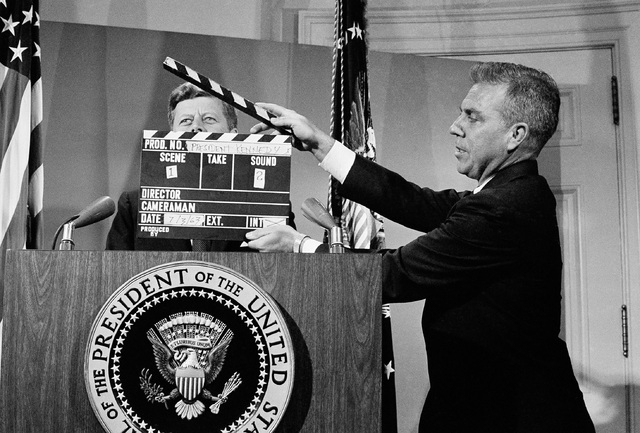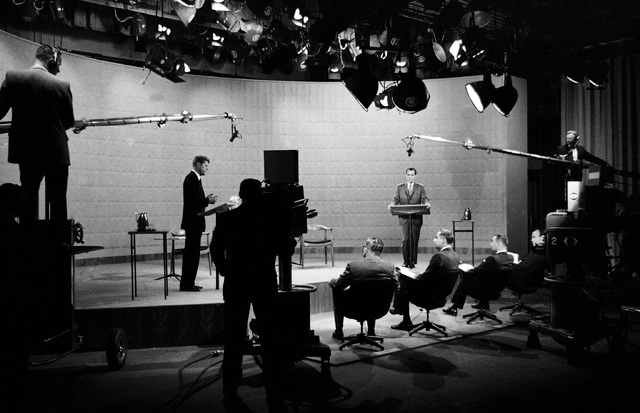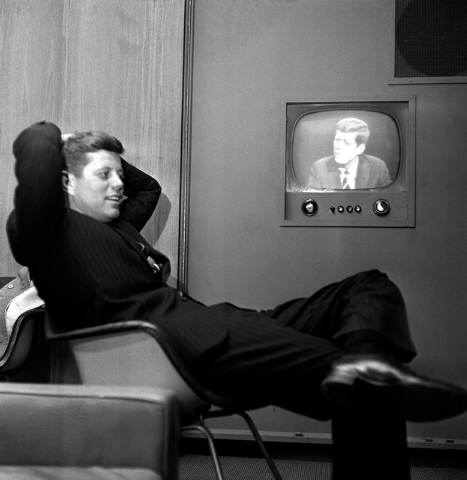In life and especially in death, JFK changed TV



NEW YORK — It’s a measure of how long ago President John F. Kennedy died that, at the time, television was described as a young medium. With the shooting in Dallas, TV grew up.
Coverage that November weekend 50 years ago signaled, at last, that television could fulfill its grand promise. It could be “more than wires and lights in a box,” in the words of newsman Edward R. Murrow, and not just the “vast wasteland” that Federal Communications Commission chairman Newton Minow had branded it just two years before.
Rising to an unprecedented challenge, television could perform an incalculable public service. It could hold the country together: Americans convened in a video vigil, gathering before an electronic hearth. Nonstop broadcasts by America’s three networks provided a sense of unity, a chance to grieve together, a startling closeness to distant events.
And television, exhaustively chronicling the murder, memorial and burial, gave viewers the final scenes of a political career ushered in almost in tandem with the video age.
In life and especially in death, John F. Kennedy changed television forever.
———
Back in 1956, TV in its infancy had introduced many Americans to the young politician as he made an unsuccessful bid for the Democratic vice presidential nomination.
Four years later, he was running for the presidency, with TV joining him on the campaign trail.
His landmark televised debates with Republican nominee Richard Nixon helped seal the deal. Some 70 million Americans watched the first debate, with the telegenic Kennedy deemed the clear winner. Televised debates would become staples of future presidential campaigns.
Once in office, Kennedy and the growing medium of television (households owning a TV had soared to 46.9 million in 1960 from 9.8 million a decade earlier, according to Nielsen) created further indelible images.
His inaugural address in 1961 was seen by millions as he urged Americans to “ask not what your country can do for you….” He charmed viewers with his televised press conferences, which were candid, off-the-cuff and sometimes talk-show-host witty.
Once, a newsman asked Kennedy if, given the burdens of the presidency, he enjoyed the job — and would he recommend it to others?
“The answer to the first is yes, and the second is no,” he quipped, his face crinkled in a grin. “I don’t recommend it to others — at least, for a while.”
Viewers loved his wife, Jackie, too. In February 1962, all three networks — CBS, NBC and ABC — aired her tour of the newly restored White House. More than 80 million Americans tuned in.
“Television brought John Kennedy and his family into America’s living rooms as had been the case with no president before,” sums up historian Robert Caro, whose books include a multi-volume biography of Kennedy successor Lyndon Johnson.
Then, on Nov. 22, 1963, and in the days that followed, TV devoted itself to an all-consuming national tragedy.
“Television intensified all the emotions of those four days. It intensified the shock and horror of the murder, and then the murder of the murderer,” Caro says, referring to Lee Harvey Oswald’s slaying. “It intensified the grief and the mourning and the mystery. And it intensified the healing process of the funeral ceremonies.”
But TV also assisted with a seldom-recognized part of the transition process, Caro adds: It reintroduced a man who for three years toiled in the margins — Johnson, Kennedy’s vice president — as he was summoned to command at a crisis point of trauma and alarm.
Says Caro, “You have to recognize the relationship of television not only to the dead president, but also to the new president taking over — his reassuring, calming effect on the public because of his demeanor.”
Johnson’s demeanor was first on display just hours after the assassination as he arrived from Dallas at Andrews Air Force Base in Washington on Air Force One, accompanying the casket and Mrs. Kennedy, still in her bloodstained pink suit.
Clustered nearby were some 50 members of the media, including NBC News correspondent Robert Abernethy, whose primary memory is how “eerily quiet” it was as they waited.
“The reporters and crews, nobody said much — or could say much,” recalls Abernethy, now 85 and still busy as the host of “Religion & Ethics Newsweekly” on PBS.
He and his counterparts from the other networks offered spare commentary on the sad scene as the newly-sworn-in Johnson stepped to the forest of microphones and, striking just the right blend of resolve and humility, told the nation, “I will do my best. That is all I can do. I ask for your help, and God’s.”
This was one of so many unforgettable moments that had begun, for many viewers, with the stark on-screen message “CBS News Bulletin” as the voice of anchor Walter Cronkite had cut into the lunch-hour soap “As the World Turns.”
“President Kennedy has been the victim of an assassin’s bullet in Dallas, Texas,” Cronkite reported. “It is not known as yet whether the president survived …”
All too soon, Cronkite, by then on camera with his eyes moist and voice choking, made his memorable pronouncement that Kennedy had died.
“We began dispatching people in all directions,” CBS News Washington bureau chief William Small says. “We sent one remote to the White House, one to the Hill. We didn’t have a third, so we improvised: We took a Greenbrier station wagon and put the guts of a remote (a camera and other equipment) in it and headed it toward Lyndon Johnson’s house.”
Like many others in command roles, Small didn’t leave the bureau for the next four days, “from the shooting to the burial.”
“When I finally got home,” he said, “I asked my wife, ‘What was it like?’ She said, ‘There was no one on the streets. Everyone was watching television.’”
Never before had the public been privy to such a seismic event beyond their own experience delivered with such you-are-there thoroughness and immediacy.
The three networks threw out regular programming and suspended commercials for blanket coverage of unfolding events in Dallas, Washington and elsewhere from Friday through Monday, a span of consecutive TV coverage not exceeded until September 2001.
And the nation was transfixed. Following the White House confirmation of Kennedy’s death, nearly half of all the country’s TV homes were in use. A few hours later, nearly two-thirds of all TV homes were tuned in. And on Monday afternoon, during the funeral coverage, viewers in 81 percent of the nation’s homes had their eyes glued to the screen, according to Nielsen.
This upended a world where people still got most of their news from print, when newsreels still accompanied the features at movie theaters.
“It was the coming of age of television news,” says Dan Rather, who was in Dallas to coordinate CBS’ coverage of a political visit by the president that was expected to produce little actual news.
At the instant Kennedy was shot, Rather was standing nearby on what was meant to be the presidential motorcade route’s last stop, where cameramen would hand off film for Rather to rush to the lab for processing.
Though he didn’t witness the shooting, the future CBS anchor saw the president’s limousine rush by and it “seemed to be heading in the wrong direction,” Rather says. “When I got over the overpass to the grassy knoll, I knew what had happened was really bad. That scene of chaos, confusion and fear in front of the textbook depository is as vivid to me today as the day I experienced it.”
ABC News’ Bob Clark was riding in the press car of the motorcade as one of the pool reporters.
“Oswald was shooting directly over the press car. We heard the shots,” Clark recalls. “Then our car raced off, following the president’s car to the hospital, not having any idea what was going on.”
At Parkland Memorial Hospital, it was immediately clear Kennedy had been gravely injured.
“The president was lying in the backseat of the limousine,” Clark reported in his first phone dispatch, “his head cradled in the first lady’s lap. At this stage there was no official word as to whether Mr. Kennedy was still alive. But he lay motionless on the backseat of the car for some two minutes while a stretcher was wheeled out from the hospital.”
The visual that viewers saw during Clark’s account wasn’t Clark, but the seal of the president of the United States. This, of course, was an age before digital technology, portable video and all but the most cursory satellite transmission. The relative primitiveness of the available tools becomes a further testament to the networks’ achievement.
For example, the cameras used for live transmission were full-size rigs, “and we only had a limited number of them,” says Small. This posed a particular challenge in covering Monday’s funeral procession in Washington.
After the funeral at St. Matthew’s Cathedral, Kennedy’s flag-draped coffin was carried on a horse-drawn caisson the several miles to Arlington National Cemetery, where he would be buried. TV covered the somber passage every foot of the way.
“We enlisted every correspondent we had,” Small recalls. And as the caisson moved past each camera position, that camera crew would leapfrog down the line beyond the next camera. “Some cameras were in four positions during the day,” Small says.
TV’s funeral coverage, even viewed today, seems perfectly suited to the occasion. It was meditative and dignified. Telecast in black-and-white (as most TV still was), the somber monochrome seems fitting as it captured Kennedy’s flag-draped coffin in the Capitol Rotunda, the riderless horse, the veiled widow with her 3-year-old son in a salute, the eternal flame at the gravesite.
These sights gave the viewer a chance to absorb, and mourn, the enormity of what had taken place.
And yet, they came just a day after an awful counterpoint: Oswald’s on-screen shooting.
It occurred during a photo op where the media could glimpse the accused assassin as he was transferred from city police custody to the county jail. NBC was on the air live when nightclub owner Jack Ruby lunged for Oswald, who, flanked by deputies, was cut down at point-blank range.
Never before had a real-life homicide aired live on TV.
“He’s been shot, Lee Oswald has been shot!” NBC correspondent Tom Pettit erupted. “It’s absolute panic here in the basement of Dallas Police headquarters.”
The other two networks had missed airing the murder live, but CBS brought a pioneering dimension to the murder scene. Within two hours, it had engineered what was likely a first for TV news: a film playback of the shooting in slow motion and freeze-frame.
Kennedy’s shooting two days earlier had not been aired live. But it was captured on film by a spectator, Abraham Zapruder, with his 8mm movie camera.
Then, amazingly, this unique visual record did not air for more than a decade. In 1963, the images seemed too disturbing for the public to behold — and 50 years later, the 486 frames continue to horrify, even as they have fueled conflicting theories of who, and how many, fired the shots.
Nowadays, the idea that the president’s every public minute could evade documenting by professional media — not to mention scores of ordinary onlookers and self-styled citizen journalists — seems inconceivable.
“In today’s world,” says Rather, “you would have had cameras all over the place, and it would have been very difficult not to have pictures of the limousine with the president slumped over” — that is, video from every angle showing the killing in high-def detail, repeatedly broadcast and viewable on YouTube.
Rather draws a cautionary picture of such a murder covered in today’s hopped-up media environment, with many rival channels digging for details while voicing on-the-fly theories of what had happened and who might be behind it.
The atmosphere of necessary restraint 50 years ago “may have worked to the country’s advantage,” Rather says. “The information the nation needed came in due course as it made its peaceful transition of power at the top.”
To argue for restraint can be heresy in journalistic circles, but even that weekend traumatized Americans were conflicted about the information coming to them via TV.
“The viewing ordeal was almost uncannily strange,” wrote The New York Times’ TV writer Jack Gould, describing “a battle within one’s self not to hear more and an uncontrollable hunger to obtain additional information.” Meanwhile, both viewers and broadcasters grappled with “an inclination to think about what the future may hold and an embarrassed realization that it was much too soon to do so.”
A half-century later, this is a struggle that TV, along with its audience, still grapples with.












